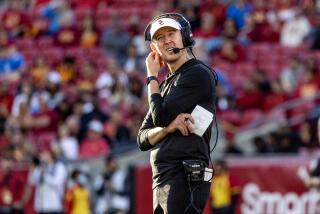Trans America Race Twists, Turns Its Way to Starting Line : Running: Preparation for event from Huntington Beach to New York City has run into several roadblocks.
- Share via
HUNTINGTON BEACH — Jesse Riley, race director of the Runner’s World Trans America Footrace--a 64-day, 2,966-mile trek from Huntington Beach to New York City--believes transcontinental running is the sport of the future.
It’s the present he’s not so sure about.
Don’t get Riley wrong. Both he and race manager Michael Kenney have faith in their inaugural event, which starts at 5 a.m. Saturday on the bike trail at the Santa Ana River jetty.
It’s just that after seven months of planning and promoting and schmoozing potential sponsors, a few annoying little details have come to their attention.
Nothing serious, really. As long as you don’t count the rental car company that recently backed out on its offer to supply vehicles for the race. Or the fact that Trans-Am organizers are $20,000 in debt. Or that even though the race filled its 25-person capacity months ago, some guy named Helmut flew in Sunday from Germany and asked where he could sign up.
Stress? What stress?
“Actually, I’m the only one around here who’s still relaxed,” said Riley, from the race’s headquarters in Huntington Beach.
Of course, those involved with Trans-Am expected to run into a roadblock here and there. At least that’s what history suggests. In 1984, the Sea to Shining Sea run promised big crowds and big bucks--$1 million for first place. But bankruptcy kept it from reaching the starting line.
In 1928, the Bunion Derby offered $25,000 in prize money. Despite a $50 entry fee, nearly 200 signed up--the race offered three meals a day, quite an incentive in the Depression years. But the race, strapped for cash, went under the next year.
But Riley and Kenney, both ultra-runners, wanted to give a coast-to-coast race another try. If anything, they hope to get the race running smoothly this year so they can compete in it next year.
That way, they too can take approximately 4,000,000 footsteps. And burn about 384,000 calories. And drink the equivalent of 1,728 cans of soda each. (Or fit into any of the other “fun facts,” Runner’s World has compiled for this race).
Runners lucky enough to get into the inaugural Trans-Am--entries were accepted on a first-come, first-serve basis--include:
--Marvin Skagerberg, 54, of Hoboken, N.J. In 1985, Skagerberg and pal Malcolm Campbell were the only entrants in the 3,559-mile Lou Gehrig Race for Life, from Los Angeles to New York City. Much of their route has been incorporated into the Trans-Am.
--Emile Laharrague, 45, of Bordeaux, France. A professional fitness trainer now living in New York City, he was one of the original entrants of the Sea to Shining Sea race and holds the French record for 1,000 miles (15 days 17 hours 58 minutes).
--Stefan Schlett, 30, of Kleinostheim, Germany. Described in Trans-Am literature as “a complete adventurer,” Schlett has bicycled across the Sahara Desert, climbed 26 mountains of more than 13,000 feet and made more than 450 parachute jumps. He has plenty of multi-day race experience and, at 26, became the youngest person to complete a 1,000-mile race.
--James (Echo) Edmunson, 49, of Los Angeles. Edmunson was an 800-meter runner at Los Angeles Manual Arts High School before he suffered a punctured lung in a knifing incident. After a long rehabilitation, he started running five- and 10-kilometer races, and eventually worked his way up to marathons and ultras.
--David Warady, 34, of Huntington Beach. Although Warady, the only Orange County entrant, is among the least experienced when it comes to multi-day races, he says his patient mind-set and injury-resistant body are made for this type of event. In preparation, Warady ran a six-day race last year and trained an average of 140 to 180 miles a week.
Warady’s coach, John Loeschhorn, held a fund-raising dinner party this week for his top ultra-running prodigy. In addition to a “good amount” of cash--Warady wouldn’t say how much--Warady collected other valuables. Namely, plenty of bags of M&Ms;, Warady’s trademark since a Globe magazine article two years ago detailed his amazing weight-loss-through-M&M-eating; story.
“I got a 48-count case of them, too,” Warady says. “They’ll be gone by Kansas.”
Riley and Kenney hoped to receive similar support. Certainly having Runner’s World as their title sponsor doesn’t hurt--the magazine is providing free publicity and advertising--but at this point, they hoped for more than a handful of product sponsors (Powerbar, Gatorade, Blimpie sandwiches).
In fact, after pouring $10,000 of their savings into Trans-Am, a family loan had to be secured, Riley says.
Aside from all this, the race will go on. Media attention has increased--Riley says he has received interest from network television in covering the finish--and the runners are ready.
Especially Helmut Schieke, the mystery entrant. Riley and Kenney received Schieke’s entry form long after the entry deadline. They sent Schieke his rejection slip and figured that was that.
On Sunday, Schieke arrived, suitcase in hand, at race headquarters. When he introduced himself as “Helmut,” Riley and Kenney figured he was Helmut Linzbichler of Austria, who was due to arrive the same day with his four-person crew.
“We’re sitting on the back porch, talking to this guy for an hour,” Riley says. “Finally, I realize he hasn’t said a word about Germany or his crew. I said, ‘You’re not Helmut Linzbichler! You’re Helmut Schieke.’
“A mail strike in Germany just happened to coincide with the time we sent his rejection slip, or so he said.”
After much deliberation--every extra runner means extra expenses--Riley and Kenney granted Schieke’s entry.
“He showed up with a wad of $50 bills a half an inch thick,” Riley says. “He said he’d pay his entry fee in cash. We figured, ‘Oh well, at least he could afford a hotel room.’ ”


